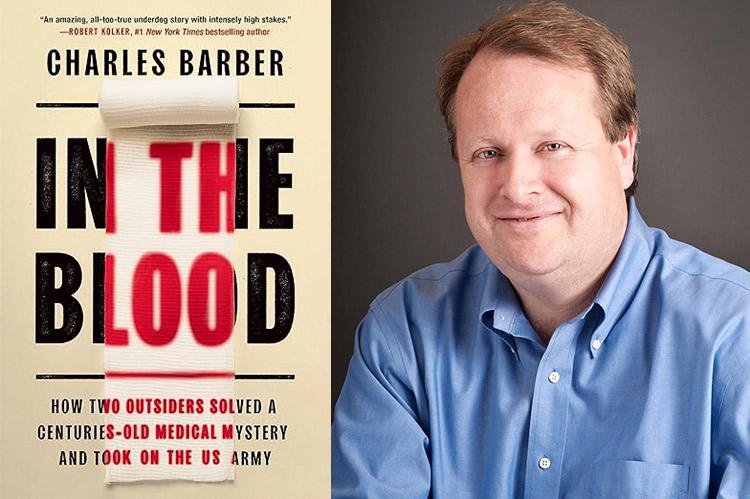“In the Blood”
Charles Barber
Grand Central Publishing, $29
While this tale involves a medical mystery, its interest is wider. Broadly, "In the Blood" dramatizes the inertia of established power and the arrogance of persons in high office versus the creative individual. And, it is a page-turner.
On one side of the drama are two small-time entrepreneurs: an introverted scientist and inventor, Frank Hursey, and an extroverted salesman, Bart Gullong. On the other side is a war hero, Major John Holcomb, M.D., of "Black Hawk Down" fame, who controls which medical products the U.S. Army will procure. The product in contention is a breakthrough method to stop fatally excessive bleeding from wounds — most important, in the field of battle.
One of the interesting aspects of this book is the portrayal of character. The two main protagonists are totally opposite as persons and as scientists.
Representing David, a lone contrarian, is Hursey, whose genius was that while "scientists had conceived of ways to clot blood only through adding something to it," he had gone in exactly the opposite direction. He "was the first person in recorded history to ever think of clotting blood by removing the water that it contained."
Representing Goliath, Holcomb was "brilliant, extraordinarily hardworking, and imbued with a powerful sense of certainty. . . . When he stated opinions, they often sounded like facts." Holcomb — we would like to believe for well-intentioned reasons — fixated on solutions to deal with excessive bleeding in the field of battle but refused to entertain the use of Hursey's product, called QuikClot, which had proven itself far more effective than the alternatives favored by Holcomb and hence the Army.
The author, Charles Barber, does an excellent job of describing the science behind the problem of blood clotting in general. He explains that the sine qua non of blood clotting is an organic protein called fibrin. Accordingly, "John Holcomb was at the center of a collaboration with the American Red Cross to create a bandage to strengthen the fibrin seal."
"Indeed, the bandage was developed and tested" and "shown to slow arterial bleeding in animals. . . . But there was a catch. The process of developing the bandage was so complex and lengthy that each bandage cost approximately $1,000."
And here we come to another rivalry within this story: between the U.S. Army and the Navy. "Lieutenant Commander Joseph Dacorta, a counterpart of Holcomb's in the navy, declined the army's request to support the project." He knew "that $1,000 a bandage was a figure one would have to multiply by more than a million in order to supply every soldier with the product. And as a former combat medic, he wondered about how the bandage [which would require refrigeration] would be adequately stored."
Consequently, "Dacorta made his first order for the navy and marines . . . of QuikClot at about ten dollars each. . . . But those in army medicine, led by John Holcomb, continued to show no interest in QuikClot. The army announced it was formally electing to go with HemCon," short for hemorrhage control, a second product favored by Holcomb, "as its blood clotting agent."
"But Dacorta had tested HemCon . . . and found it completely impractical." Dacorta's judgment proved correct. As a general later testified to Congress, "the product fails to work in field applications sixty-six percent of the time and the product costs $98.00 per bandage . . . while QuikClot works one hundred percent of the time with zero percent mortality and costs $9.80 per package."
Holcomb's intransigence led to yet a third failed product, Factor Seven, which ended up in a major Justice Department case and a costly settlement by its manufacturer, Novo Nordisk.
The story continues in this vein, the Army investing huge sums and failing, product after product, but steadfastly refusing to accept Hursey's QuikClot bandage.
It is a case in point, illustrating, as the author comments, how "the American military — and the army in particular — had a protracted history of favoring failed products made by military insiders over effective products made by outside innovators who had no political clout."
There is a happy ending to this tale that I will not spoil for the reader. Happy, at least, for Frank Hursey and Bart Gullong, who sold their product — now known as QuikClot Combat Gauze — to a pharmaceutical manufacturer, but not so happy for what it says about the American military, "among the largest and most opaque bureaucracies in existence."
This time David won — as in the Bible — but we don't know how often his counterparts have lost or are still losing.
Ana Daniel, retired from business and teaching, lives in Bridgehampton.
Bart Gullong formerly lived in Sag Harbor.

